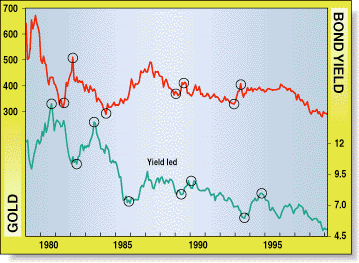INTERMARKET ANALYSIS
Of Gold And Bonds, Gold Is The Leader
by Alex Saitta
Does gold lead the bond market, or is it the other way around?

To answer this question, we applied basic statistical analysis to measure relationships between two series of data. Correlation analysis measures the degree of association between all the data points of two series. The product of this mathematical comparison is referred to as the correlation coefficient. Correlation coefficients range from -1.0 to +1.0 and identify the direction as well as the strength of a relationship between the two series being compared.FIGURE 1: GOLD VS. YIELDS. In a quick look at the past 20 years of data, gold's reversals appear to have led bond yield reversals.
For example, a coefficient of +1.0 represents a perfect positive relationship. When one variable rises, the other rises in lockstep. When one falls, the other falls in lockstep. A coefficient between zero and less than +1.0 is a nonperfect positive relationship. When one variable rises, the other usually rises somewhat. When one falls, the other usually falls somewhat.
A coefficient of zero, however, indicates no relationship. A coefficient of -1.0 is a perfect negative relationship. When one variable rises, the other falls in lockstep. When one falls, the other rises in lockstep. A coefficient greater -1.0 and less than zero is a nonperfect negative relationship. When one variable rises, the other usually falls somewhat. When one falls, the other usually rises somewhat.
WHAT IF?
If gold is a leader, its correlation with the bond yield will be greatest when gold is lagged a certain number of periods. A simple example can be seen in Figure 2. Series A leads series B by five periods, so whatever occurs in series A in a period will be reflected in series B five periods later. For example, series A fell from periods 1 through 9 and then made a low. Series B, lagging five periods, fell periods 6 through 14 and then made a low. In period 13, series A put in a short-term high, and five periods later -- period 18 -- series B made a high. If a correlation analysis is performed on these two series and series A is lagged five periods, the correlation would be a perfect +1.0.